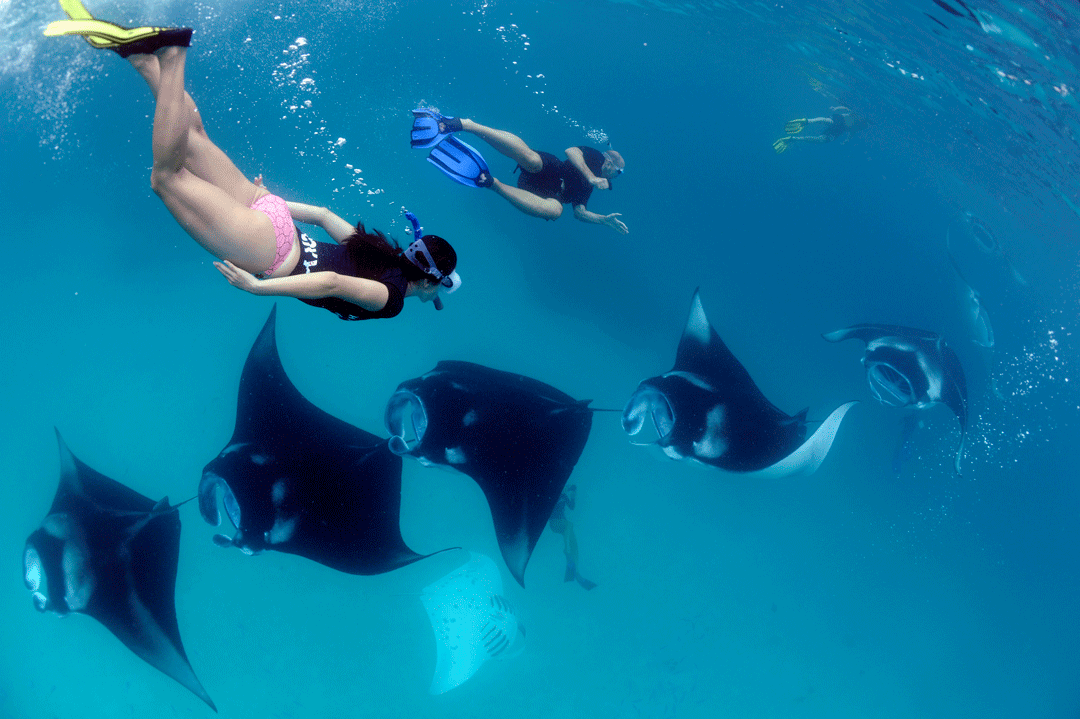Protecting the Million-Dollar Mantas
In light of increased fishing pressure on manta and devil ray populations worldwide, an alternative and more sustainable economic practice is blossoming. Manta ecotourism now generates over USD 140 million annually worldwide, with increasing numbers of tourists wanting to catch a glimpse of the enigmatic mantas. In the Maldives, home of the Manta Trust’s Maldivian Manta Ray Project, the industry is worth an estimated USD 8.1 million per year. The Maldives Archipelago has the world’s largest recorded population of reef manta rays, making it a hotspot for tourists to snorkel and SCUBA with these marine favourites. However, to ensure this emerging industry remains sustainable, it is imperative that we monitor and regulate human interactions to avoid disturbing or altering the mantas’ natural behaviour. This is the subject of my newly published research paper ‘Protecting the million-dollar mantas; creating an evidence-based code of conduct for manta ray tourism interactions’.

Snorkelers with reef mantas in Hanifaru Bay, Maldives. Photo © Guy Stevens | Manta Trust
Manta rays are known for their docile and curious nature and in certain parts of the world aggregate in large numbers, sometimes exceeding 200 individuals in order to feed on ephemeral zooplankton blooms. These thick concentrations of food can be rich and dense but also fleeting, therefore any disturbance to their feeding behaviour can drastically impact manta health. Many of the key manta snorkel locations in the Maldives are at these feeding sights, hence manta rays are being exposed to increasing human presence in the water during this vital activity. Building on previous research by the Manta Trust, who published a Best Practice Code of Conduct for Manta Ray Tourism, we wanted to test the science behind these interaction recommendations. Using a specially designed research protocol, we established the specific human behaviours, approaches and distance parameters to test for the presence of manta disturbance or feeding cessation during human-manta interactions at snorkel locations in Baa Atoll, Maldives.

Snorkeler observing a reef manta in Hanifaru Bay, Maldives. Photo © Guy Stevens | Manta Trust
During the busy manta months of July and August, our visiting York University Masters student, Eleanor Garrud and I spent two months collecting a large body of data from the key snorkel locations which we rigorously analysed. So, what did we find? From our statistical analysis of the human-manta interaction data collected, we can make clear recommendations for in-water interactions with feeding manta rays. Supporting the Manta Trust’s published code of conduct, when in the water with manta rays, snorkelers should; (1) maintain a distance of three metres or more when approaching, (2) remain passive throughout interactions avoiding splashing, touching or chasing animals, (3) if approaching animals, always approach from the side, within the manta ray’s field of vision, (4) avoid diving directly in front of the animals, and (5) only experienced snorkellers should attempt to free-dive near manta rays. We are already working on the next phase of this research, looking at the same parameters and behaviour during SCUBA interactions at cleaning stations throughout the Maldives. Through this research, we hope to work towards nationwide government legislation in countries where manta ray tourism activities exist. If this is achieved, manta ray tourism can become a safe and sustainable alternative to fishing, which will produce lasting financial gains for the local economy and tourism trade.
Please take a moment to check out the Manta Trust’s Swim with Mantas website which equips operators and tourists with the tools and information they need to make their excursions truly sustainable for the gentle giants we all know and love.
